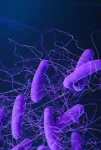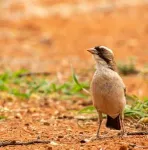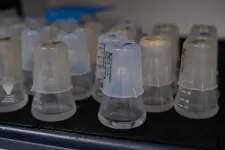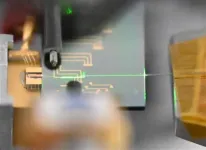Side-effect avoiding treatment shows early promise against breast cancer in mice
New study highlights the potential of molecules known as narrow-spectrum Wnt signaling inhibitors
2023-11-09
(Press-News.org) New experimental evidence suggests that substances known as narrow-spectrum Wnt signaling inhibitors—which could have fewer side effects than other related substances—are capable of suppressing the growth of breast cancer tumors in mice. Aina He of Shanghai Jiaotong University Affiliated Sixth People’s Hospital, China, and colleagues present these findings November 9th in the open access journal PLOS Biology.
While certain subtypes of breast cancer can be targeted with special medications, others can only be treated with standard chemotherapy. For some patients, chemotherapy may lead to the growth of stem cell-like cancer cells that are drug resistant. Previous studies suggest that medications that inhibit a specific biological process called Wnt signaling could potentially combat these cells, but so far, the potential benefits of Wnt signaling inhibitors have been hampered by their damaging side effects, particularly on bone density.
These side effects arise from the fact that humans have ten different versions of the Wnt signaling receptor, Frizzled, with distinct functions. Researchers have therefore recently developed new Wnt signaling inhibitors that could reduce side effects by targeting just three of these receptors. However, it has been unclear how effective these narrow-spectrum Wnt signaling inhibitors might be at treating cancer.
To shed new light, He and colleagues conducted a series of experiments with a specific narrow-spectrum Wnt signaling inhibitor known as TcdBFBD, which was derived from a toxin found naturally in the bacterial species Clostridium difficile. They tested TcdBFBD in several different mouse models that mimic different types of breast cancer—basal-like and luminal-like—found in humans.
The researchers found evidence suggesting that TcdBFBD suppressed tumor growth and reduced the activity of stem cell-like cancer cells in the mice, without side effects on bone density. They also found evidence that TcdBFBD can synergize with the standard chemotherapy drug cisplatin to inhibit both basal-like and luminal-like breast cancer tumors in mice.
These findings provide preliminary evidence for the potential therapeutic promise of narrow-spectrum Wnt signaling inhibitors like TcdBFBD. However, more research will be needed to investigate their effectiveness in humans, examine how they might synergize with other cancer treatments beyond cisplatin, and explore their effects in additional types of cancer—such as serous ovarian cancer and oral squamous cell carcinoma.
The authors add, “A bacterial toxin fragment targets and suppresses breast cancer tumor-initiating and chemo-resistant cells.”
#####
In your coverage, please use this URL to provide access to the freely available paper in PLOS Biology: http://journals.plos.org/plosbiology/article?id=10.1371/journal.pbio.3002353
Citation: He A, Tian S, Kopper O, Horan DJ, Chen P, Bronson RT, et al. (2023) Targeted inhibition of Wnt signaling with a Clostridioides difficile toxin B fragment suppresses breast cancer tumor growth. PLoS Biol 21(11): e3002353. https://doi.org/10.1371/journal.pbio.3002353
Author Countries: United States, China, the Netherlands
Funding: This study was partially supported by St. Baldrick’s Foundation (585350 to A.H.), Burroughs Wellcome Fund (to M.D.), Natural Science Foundation of Shanghai, China (16ZR1425900 to A.H.), National Natural Science Foundation of China (82173358 to A.H.), and US Department of Defense Breast Cancer Research Program Breakthrough Awards (W81XWH-15-1-0100 and W81XWH-18-1-0037 to Z.L.). The funders had no role in study design, data collection and analysis, decision to publish, or preparation of the manuscript.”
END
ELSE PRESS RELEASES FROM THIS DATE:
2023-11-09
As conceived by Charles Darwin in the 1800s, evolution is a slow, gradual process during which species adaptations are inherited incrementally over generations. However, today biologists can see how evolutionary changes unfold on much more accelerated timescales.
Rather than the evocative plants and animals of the Galapagos Islands that Darwin studied in forming his theory of evolution, Postdoctoral Scholar Joshua Borin and Associate Professor Justin Meyer of UC San Diego’s School of Biological Sciences are documenting rapid evolutionary processes in simple laboratory flasks.
Borin ...
2023-11-09
Although the group’s work has been freely available since its inception in March 2020, the COVID Moonshot Consortium is finally formally reporting their results. The COVID Moonshot – an open-science, crowdsourced, and patent-free drug discovery campaign targeting the SARS-CoV-2 virus – has yielded a wealth of data on the virus’s main protease, including insights that could pave the way for the development of new and better therapeutics. “The lead therapeutics described by [these researchers] may not be ready in time to affect the current pandemic, considering the timelines and challenges of drug approval,” write Brian Shoichet and Charles ...
2023-11-09
Setting out to improve a technology that usually requires bulky, bench-top equipment, Quishi Guo and colleagues have shrunk a mode-locked laser (MLL) to the size of an optical chip with an integrated nanophotonic platform. The results show promise for developing ultrafast nanophotonic systems for a wide range of applications. Mode-locked lasers (MLLs) can produce coherent ultrashort pulses of light at extremely fast speeds – on the order of picoseconds and femtoseconds. These devices have enabled numerous technologies in photonics, including extreme nonlinear optics, two-photon microscopy, ...
2023-11-09
Drawing on 30 years of data, researchers show that the number of homes within wildfire perimeters in the U.S. has doubled since the 1990s. This increasing risk is driven by both an increase in wildfires and the expansion of new homes into wildfire-prone areas, especially in the wildland-urban interface. Wildfire risks to homes are increasing, particularly in the wildland-urban interface (WUI), where houses and wildland vegetation are in close proximity. Over the last 12 years, more than 55,000 homes in the U.S. have been lost to wildfires due to rapid increases ...
2023-11-09
Two studies highlight new glass- and ceramic-based passive radiative cooling materials. Unlike passive radiative cooling approaches that rely on polymers, these hard materials are more durable and versatile, making them more attractive for a wide range of outdoor passive cooling applications, including those that could help reduce the need for air conditioning. The energy demand for cooling continues to rise, particularly in regions rapidly warming due to climate change. To make matters worse, the growing carbon footprint of cooling systems further contributes to global warming, exacerbating the need for cooling solutions. Passive radiative cooling (PRC) materials, which ...
2023-11-09
UCLA researchers have described a previously unknown step in the complex process by which dietary cholesterol is processed in the intestines before being released into the bloodstream – potentially revealing a new pathway to target in cholesterol treatment.
Although an existing drug and statins impact part of the process, an experimental drug being studied in UCLA research labs appears to specifically target the newfound pathway, possibly adding a new approach to the cholesterol management toolbox.
“Our results show that certain proteins in the Aster family play a critical role in moving cholesterol through the absorption and uptake process,” said ...
2023-11-09
Desert birds lay larger eggs when they have more helpers to feed their chicks, new research shows.
White-browed sparrow weavers live in family groups in which only a dominant pair breeds and their grown-up offspring, particularly females, help to feed nestlings.
The study, by researchers at the University of Exeter, found that mothers increased the size of their eggs when they had more female helpers on hand.
The number of male helpers did not affect egg size, probably because male helpers feed chicks at substantially lower rates than female helpers.
“We don’t yet fully understand why helped mothers are laying heavier ...
2023-11-09
People are beginning to reconsider their reproductive decisions due to complex concerns about climate change, with many choosing to forego childbearing, or reduce the number of children they have as a result, finds a new study by UCL researchers.
The research, published in PLOS Climate, is the first systematic review to explore how and why climate change-related concerns may be impacting reproductive decision-making.
The team examined 13 studies, involving 10,788 participants, which were conducted between 2012 and 2022, primarily in Global North countries ...
2023-11-09
Lasers are essential tools for observing, detecting, and measuring things in the natural world that we can’t see with the naked eye. But the ability to perform these tasks is often restricted by the need to use expensive and large instruments.
In a newly published cover-story paper in the journal Science, researcher Qiushi Guo demonstrates a novel approach for creating high-performance ultrafast lasers on nanophotonic chips. His work centers on miniaturizing mode-lock lasers — a unique laser that emits a train of ultrashort, coherent light pulses in femtosecond intervals, which is an astonishing quadrillionth ...
2023-11-09
An international group of 35 scientists is calling out conflicts of interest plaguing global plastic treaty negotiations and that have interfered with timely action on other health and environmental issues. They urge the implementation of strict guidelines to prevent the same problems from affecting the UN’s upcoming Science Policy Panel on chemicals. Their concerns and recommendations are outlined in a featured paper in the journal Environmental Science & Technology.
“From Big Tobacco to Big Oil, powerful industries use the same playbook to manufacture doubt and sow misinformation,” said co-author Bethanie ...
LAST 30 PRESS RELEASES:
[Press-News.org] Side-effect avoiding treatment shows early promise against breast cancer in mice
New study highlights the potential of molecules known as narrow-spectrum Wnt signaling inhibitors





